If you’re wondering what are the best Foreground Aquarium Plants? this guide will fill you with tank design ideas and 10 new great options!
Being situated at the front of the tank, these plants play a significant role in the visual aesthetics of an aquarium, acting as a carpet or a low lying green layer. They also provide an excellent habitat for small aquatic creatures, promoting biodiversity in the tank.
- Related: 12 Best Carpeting Plans
- Related: Best Stem Plants
- Related: 7 Rare & 11 Common Aquarium Mosses
- Related: Top 16 Background Plants
- Related: Top 10 Aquarium Foreground Plants
These plants’ petite stature is of considerable importance. A small size is crucial for maintaining the balance of the landscape, ensuring they don’t obstruct the view of other plants or aquatic life. Additionally, smaller plants tend to grow densely, offering a lush, vibrant look that is very appealing.
They also use up less of the water column, leaving room for a diverse range of flora and fauna, thus contributing to a more balanced ecosystem. From providing shelter to bottom-dwelling species to enhancing the visual appeal, these tiny foreground freshwater plants prove that size does not always dictate significance.
Their small form and robust growth serve as a testament to the adage that ‘good things come in small packages’. Lets jump right in with our first plant.
Table of Contents
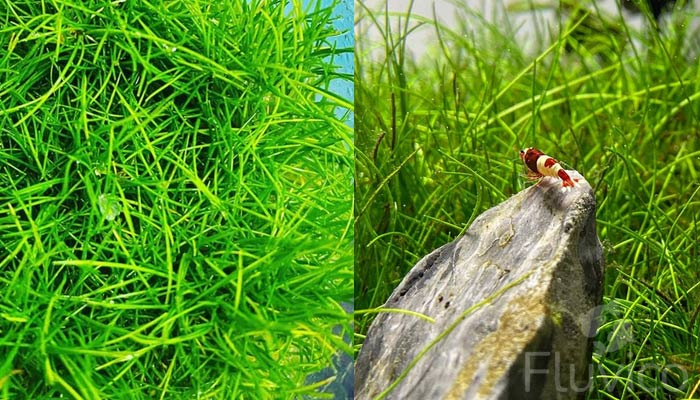
Dwarf Hairgrass (Eleocharis Parvula)
Dwarf Hairgrass is a popular, versatile freshwater aquarium plant. With its thin, spiky leaves, it emulates an underwater lawn, adding texture and a natural green hue to the foreground of aquatic environments.
- Size: Its short stature allows for a front row placement without obstructing tank views.
- Growth: It spreads rapidly, creating a dense underwater grassland when provided adequate light and nutrients.
- Environment: It thrives in various lighting conditions but prefers moderate to high light levels for optimal growth.
- Aesthetic: Its lawn-like appearance brings a unique texture and enhances the aquatic landscape’s overall look.
- Habitat: Its dense growth provides shelter and feeding grounds for bottom-dwelling creatures, promoting biodiversity.
- Maintenance: Requires trimming to maintain its grass-like appeal and prefers substrate rich in nutrients for best growth.
- Water Temperature: Dwarf Hairgrass (Eleocharis Parvula) thrives in a temperature range of 50°F to 83°F (10°C to 28°C).
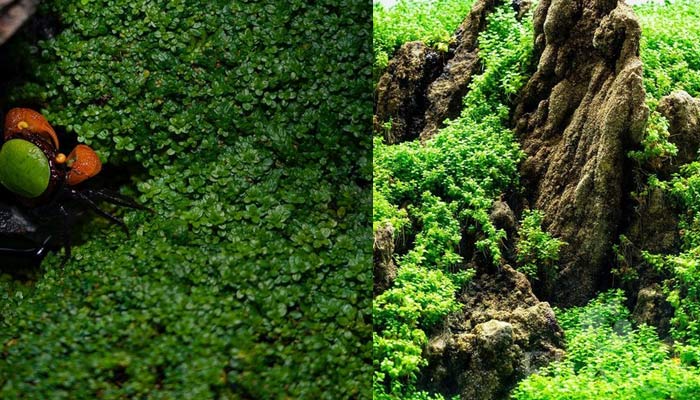
Dwarf Baby Tears (Hemianthus Callitrichoides)
Dwarf Baby Tears, scientifically known as Hemianthus Callitrichoides, is one of the smallest aquarium plants in the world. Renowned for its bright green color and compact size, it creates a stunning carpet effect in freshwater tanks. This plant offers a dense, lush foreground layer that adds depth and dimension to any aquatic landscape.
- Size: Due to its minute size, it’s perfect for foreground placement in a tank, not obscuring views of other plants or aquatic creatures.
- Growth: It grows rapidly under the right conditions and can quickly cover the bottom of the aquarium with its lush, vibrant carpet.
- Environment: Dwarf Baby Tears is a versatile plant that can thrive in both low and high light conditions, although it flourishes best with high light and carbon dioxide.
- Aesthetic: Its bright green leaves provide a vivid color contrast against dark substrate or aquatic backgrounds, boosting the visual appeal of the tank.
- Habitat: It offers a great habitat for smaller aquatic creatures, providing them with shelter and contributing to the overall biodiversity in the tank.
- Maintenance: Although this plant requires a bit more care compared to other aquarium plants due to its need for ample lighting and CO2, it’s well worth the effort for the beautiful result it delivers.
- Water Temperature: prefers a temperature range of 70°F to 84°F (21°C to 29°C).

Marsilea Minuta
Also known as Dwarf Clover, Marsilea Minuta is a petite freshwater aquarium plant with clover-like fronds. Offering a rustic appeal to the tank’s foreground, its low growth habit forms a vibrant carpet across the aquarium floor.
- Size: Its small stature ensures it doesn’t dominate the view, ideal for foreground positioning.
- Growth: Spreads horizontally to form a lush, green carpet.
- Environment: Adapts well under low to medium light and doesn’t require CO2.
- Aesthetic: Clover-shaped fronds add a unique, visually appealing element.
- Habitat: Provides shelter for small aquatic species, fostering biodiversity.
- Maintenance: Low-maintenance and requires consistent light exposure.
- Water Temperature: Thrives best in temperatures ranging from 68°F to 82°F (20°C to 28°C).
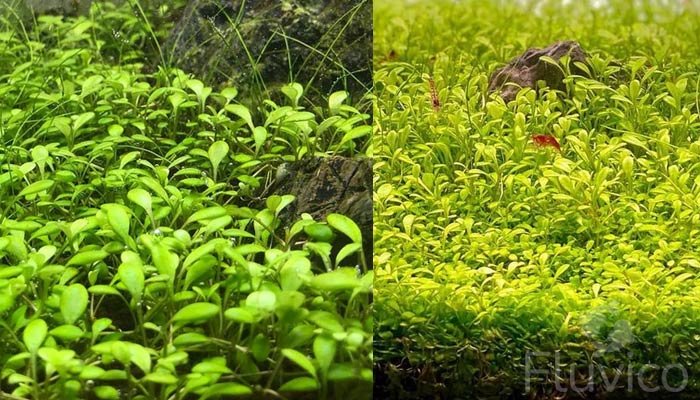
Glossostigma Elatinoides
Glossostigma Elatinoides is a small, fast-growing freshwater plant known for its teardrop-shaped leaves. Its vibrant green hue and carpeting ability bring vitality to the aquarium foreground, contributing to a captivating underwater panorama.
- Size: With its small structure, it’s perfect for maintaining clear sightlines in the tank.
- Growth: Spreads quickly, forming a verdant, dense carpet in favorable conditions.
- Environment: Prefers high light levels and a good supply of CO2 to flourish.
- Aesthetic: The striking green shade of its leaves enlivens the overall aesthetic.
- Habitat: The dense carpet provides shelter and exploration grounds for small aquatic species.
- Maintenance: Requires regular trimming to manage its rapid growth.
- Water Temperature: Ideal growth occurs between 70°F and 82°F (21°C to 28°C).

Cryptocoryne Parva
Cryptocoryne Parva is a delightful, slow-growing freshwater plant. With slender, pointed leaves that remain green year-round, it adds a consistent lushness to the aquarium’s foreground, creating a serene and attractive landscape.
- Size: Its diminutive size ensures an unobstructed view of the tank, making it ideal for foreground placement.
- Growth: Despite being one of the slowest growing Cryptocorynes, it forms a dense, uniform carpet over time.
- Environment: Thrives in low to moderate lighting and does not require CO2 supplementation.
- Aesthetic: The unchanging green color of its leaves maintains a consistent, pleasant aesthetic.
- Habitat: Its dense growth provides a perfect hiding spot for small aquatic creatures, promoting tank biodiversity.
- Maintenance: Very low-maintenance and does not require frequent trimming.
- Water Temperature: Performs best in a range of 72°F to 82°F (22°C to 28°C).

Pygmy Chain Sword (Echinodorus Tenellus)
Echinodorus Tenellus, also known as Pygmy Chain Sword, is a versatile freshwater plant with slender, arching leaves. Its rapid growth and ability to adapt to various conditions make it a favored choice for adding a lush, green carpet effect to the aquarium’s foreground.
- Size: Its petite stature doesn’t obstruct the aquarium’s view, ideal for front placement.
- Growth: Spreads swiftly, forming a dense carpet on the tank’s floor.
- Environment: Adaptable to a variety of lighting conditions, from low to high, and requires no CO2.
- Aesthetic: Its arching leaves add a unique visual element to the overall tank aesthetic.
- Habitat: The dense carpet-like formation offers shelter and hunting grounds for small aquatic life.
- Maintenance: Requires regular trimming due to its rapid growth.
- Water Temperature: Prefers a temperature range of 68°F to 83°F (20°C to 28°C).
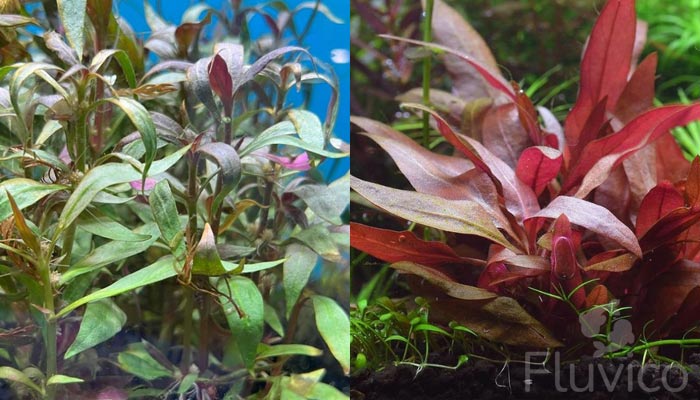
Alternanthera Reineckii
Alternanthera Reineckii is a striking and sought-after freshwater plant that brings a vibrant touch to aquariums. With its rich red hues and graceful leaf structure, it adds an eye-catching element to any aquascape, whether as a focal point or part of the background.
- Size: Medium-sized freshwater plant, suitable for the middle or background of the aquarium.
- Growth: Exhibits moderate growth rate, requiring nutrient-rich conditions to maintain its vibrant red coloration.
- Environment: Adaptable to a wide range of lighting conditions, making it suitable for various aquarium setups.
- Aesthetic: Adds a captivating visual element with its intense red hues and graceful leaf structure.
- Habitat: Provides shelter and hiding spots for small aquatic species, contributing to the overall biodiversity of the tank.
- Maintenance: Regular pruning is necessary to manage growth and maintain the desired shape.
- Water Temperature: Thrives best within a temperature range of 68°F to 82°F (20°C to 28°C).

Micro Sword (Lilaeopsis Brasiliensis)
The Micro Sword, or Lilaeopsis Brasiliensis, is a popular freshwater plant known for its thin, blade-like leaves and its ability to form a carpet mimicking a miniature underwater meadow. This versatile plant enriches the aquarium foreground with a unique texture and vibrant green color.
- Size: Its petite size is perfect for maintaining clear views in the aquarium, ideal for the foreground.
- Growth: Spreads gradually to form a dense, grass-like carpet.
- Environment: It thrives best under moderate to high light conditions; CO2 supplementation can promote denser growth.
- Aesthetic: Its grass-like appearance adds a dynamic and natural aesthetic to the tank.
- Habitat: The dense growth provides hiding spots and feeding grounds for small aquatic species.
- Maintenance: Occasional trimming is needed to maintain its meadow-like appeal.
- Water Temperature: It thrives best at temperatures ranging from 70°F to 83°F (21°C to 28°C).
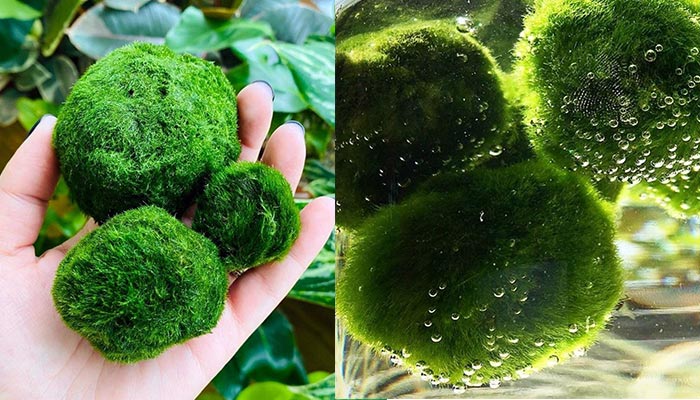
Marimo Moss Ball (Aegagropila Linnaei)
The Marimo Moss Ball, a form of green algae, is an intriguing addition to freshwater tanks. With its perfectly round shape and lush green color, this unique plant not only enhances the aesthetic appeal of the foreground but also contributes to water purification.
- Size: Its round, compact size doesn’t interfere with sightlines in the aquarium, making it ideal for the foreground.
- Growth: Growth is slow, but maintains a consistent, spherical shape over time.
- Environment: Thrives in low to medium light conditions; no CO2 supplementation required.
- Aesthetic: Its spherical shape and deep green color add an unusual and captivating visual element.
- Habitat: Its surface provides a grazing area for small aquatic creatures and shrimp.
- Maintenance: Very low-maintenance; occasional rotation helps maintain its round shape.
- Water Temperature: Ideal temperature range is between 64°F to 78°F (18°C to 25°C).

Staurogyne Repens
Staurogyne Repens is a vibrant green freshwater plant known for its robust growth and bushy appearance. Often used to create a dense carpet effect in the foreground, it adds a touch of lushness and texture to any aquarium landscape.
- Size: Its compact size allows for unobtrusive foreground placement without blocking aquarium views.
- Growth: Exhibits robust growth to form a lush, dense carpet or bush-like clusters.
- Environment: Flourishes under medium to high light conditions; CO2 supplementation encourages denser growth.
- Aesthetic: Its bushy appearance contributes a unique texture and dense greenery to the tank.
- Habitat: Provides shelter and grazing areas for small aquatic creatures.
- Maintenance: Requires regular trimming to maintain its compact, bushy shape.
- Water Temperature: Performs best within a temperature range of 68°F to 86°F (20°C to 30°C).
Can Stem Plants Stay Small For Foreground?
While stem plants are often used for the middle or background of aquariums due to their potential for significant height, some varieties can also be successfully used in the foreground. This is particularly true when they’re regularly trimmed to maintain a smaller, more compact size.
These plants can add depth, color, and visual interest to the foreground of your aquarium while providing shelter and food for various aquatic creatures. Some of these small stem plants suitable for the foreground include ‘dwarf’ or ‘compact’ varieties of species like Hygrophila, Rotala, and Ludwigia. The key is to manage their growth carefully to maintain the desired size and shape. 
So, from the verdant carpeting of Dwarf Baby Tears to the unique round shape of Marimo Moss Balls, each of these freshwater plants adds a distinct touch of nature to your aquarium.
Whether providing shelter for smaller creatures or enhancing the overall aesthetics, these plants contribute significantly to a vibrant and healthy aquatic ecosystem. Their compact size makes them perfect foreground options, letting the beauty of your entire aquatic landscape shine through. Choose wisely and let your aquarium thrive!
More Reading
- 15 Types of Cryptocoryne: Which is Best For Your Aquarium Setup?

- 16 Awesome Low Light Aquarium Plants (Mosses, Ferns & Stem Plants)

- 16 Fast Growing Freshwater Aquarium Plants

- 18 Types of Aquarium Moss: Photos, Care, Propagation & Growth Guide

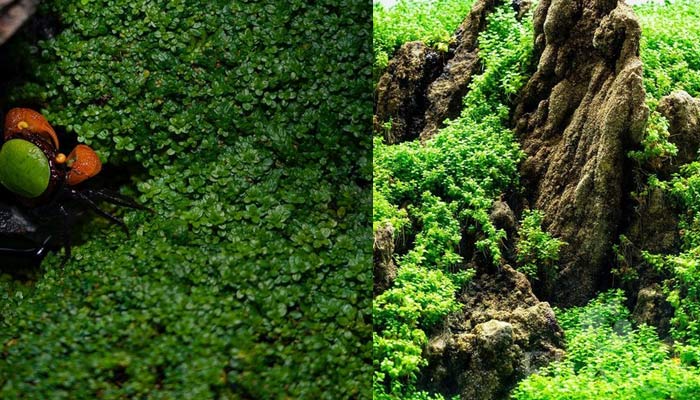
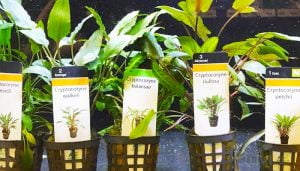
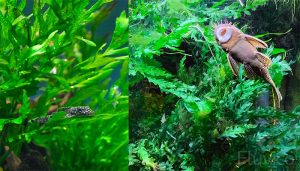
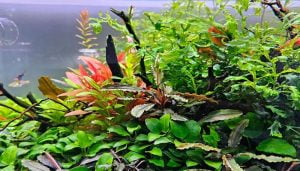

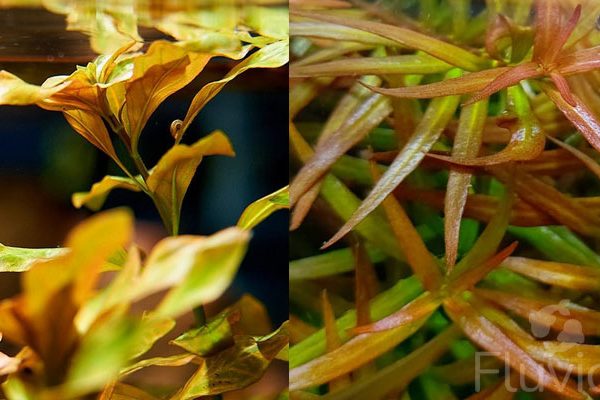
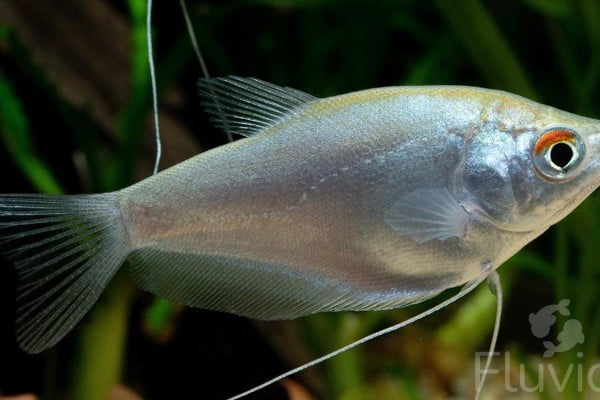
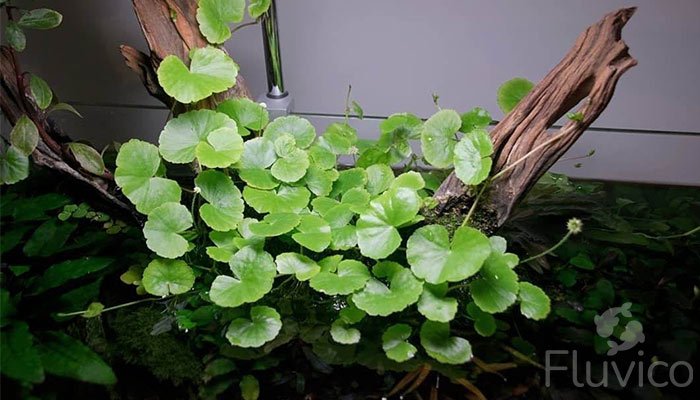

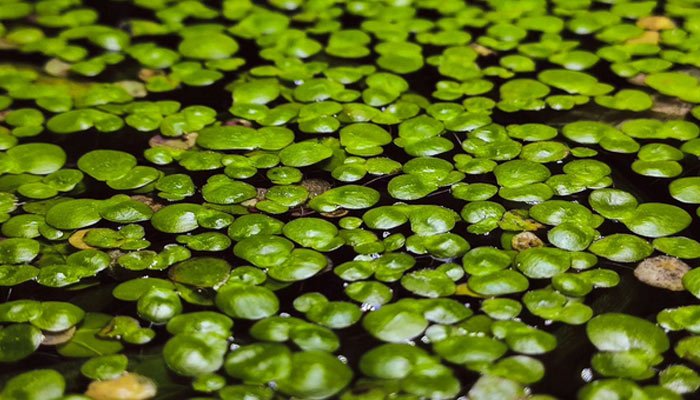
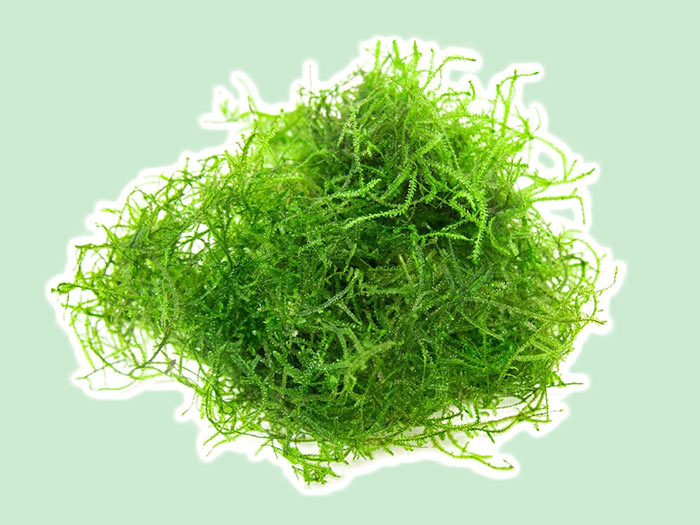
Hope you enjoyed our Top 10 Foreground Plants.
If you have any questions? Ask away, we’re here to help!
All the best,
Daniel